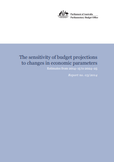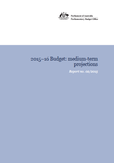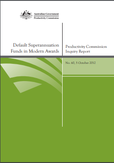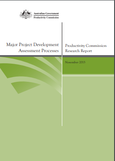Professional work experience - public sector
This page provides links to examples of work I have led/contributed to in various professional economist roles across the public sector (Commonwealth and Victoria public sectors). These include senior roles at:
- the Parliamentary Budget Office (Commonwealth, Director, Fiscal Policy Analysis)
- the Productivity Commission (Commonwealth, Assistant Commissioner)
- Department of Premier and Cabinet (Victoria, various roles within Economic Policy Branch)
- Department of Treasury and Finance (Victoria, various roles with Budget Division and Economic and Financial Policy Division)
- Graduate roles including at Commonwealth Treasury (Budget Policy Branch) and the former Industry Commission (Labour Market Research Branch).
Parliamentary Budget Office
While I was a Director, Fiscal Policy Analysis at the Parliamentary Budget Office, I led a team of economists on the following reports related to the Commonwealth Budget. This included the following:
While I was a Director, Fiscal Policy Analysis at the Parliamentary Budget Office, I led a team of economists on the following reports related to the Commonwealth Budget. This included the following:

The sensitivity of budget projections to changes in economic parameters: estimates from 2014–15 to 2024–25 (report no. 03/2014)
Summary:
The medium-term projections in the Australian Government’s 2014–15 Budget show the budget achieving balance in 2018–19 and a surplus of 1.4 per cent of GDP in 2024–25, with tax receipts capped at 23.9 per cent of GDP. Total receipts are projected to rise from 23.6 per cent of GDP in 2014–15 to 25.8 per cent of GDP in 2024–25. The ratio of payments to GDP is projected to fall from 25.3 per cent in 2014–15 to 24.2 per cent in 2024–25. Net debt is projected to fall from 13.9 per cent of GDP in 2014–15 to 0.7 per cent of GDP in 2024–25. As the 2014–15 Budget Papers state, the projected fiscal consolidation over the medium term is based on Australia experiencing a further 10 years of uninterrupted economic growth. The performance of the economy is a key factor in the sustainability of the budget over the medium term. Growth in the nominal economy is the main driver of government revenue. Australia’s economic performance and hence its fiscal position is sensitive to changes in a number of economic parameters. This report examines the sensitivity of the 2014–15 Budget medium-term projections to a range of positive and negative shocks to three key economic parameters: labour productivity growth, the labour force participation rate and the terms of trade.
Summary:
The medium-term projections in the Australian Government’s 2014–15 Budget show the budget achieving balance in 2018–19 and a surplus of 1.4 per cent of GDP in 2024–25, with tax receipts capped at 23.9 per cent of GDP. Total receipts are projected to rise from 23.6 per cent of GDP in 2014–15 to 25.8 per cent of GDP in 2024–25. The ratio of payments to GDP is projected to fall from 25.3 per cent in 2014–15 to 24.2 per cent in 2024–25. Net debt is projected to fall from 13.9 per cent of GDP in 2014–15 to 0.7 per cent of GDP in 2024–25. As the 2014–15 Budget Papers state, the projected fiscal consolidation over the medium term is based on Australia experiencing a further 10 years of uninterrupted economic growth. The performance of the economy is a key factor in the sustainability of the budget over the medium term. Growth in the nominal economy is the main driver of government revenue. Australia’s economic performance and hence its fiscal position is sensitive to changes in a number of economic parameters. This report examines the sensitivity of the 2014–15 Budget medium-term projections to a range of positive and negative shocks to three key economic parameters: labour productivity growth, the labour force participation rate and the terms of trade.

2015-16 Budget: medium-term projections (report no. 02/2015)
Summary:
The 2015–16 Budget papers include projections of the underlying cash balance and net debt to 2025–26 but do not include projections of receipts and payments beyond the forward estimates period ending 2018–19. In this report the Parliamentary Budget Office (PBO) provides detailed projections of receipts and payments over the period beyond the forward estimates to 2025–26. The PBO’s projections are based on the 2015–16 Budget forward estimates, the economic forecasts and other parameters underpinning the 2015–16 Budget and the policy settings current as at the 2015–16 Budget. The PBO’s projections are not forecasts or predictions, but provide a detailed projected budget baseline over the medium term assuming no change in policy settings over the projection period.
Summary:
The 2015–16 Budget papers include projections of the underlying cash balance and net debt to 2025–26 but do not include projections of receipts and payments beyond the forward estimates period ending 2018–19. In this report the Parliamentary Budget Office (PBO) provides detailed projections of receipts and payments over the period beyond the forward estimates to 2025–26. The PBO’s projections are based on the 2015–16 Budget forward estimates, the economic forecasts and other parameters underpinning the 2015–16 Budget and the policy settings current as at the 2015–16 Budget. The PBO’s projections are not forecasts or predictions, but provide a detailed projected budget baseline over the medium term assuming no change in policy settings over the projection period.
Productivity Commission
While I was an Assistant Commissioner at the Productivity Commission I led teams of economists on inquiry and study projects for the Australian Government. This included the following:
While I was an Assistant Commissioner at the Productivity Commission I led teams of economists on inquiry and study projects for the Australian Government. This included the following:

Default Superannuation Funds in Modern Awards
Summary:
The Australian Government asked the Commission to undertake an inquiry into default superannuation funds in modern awards. The purpose of the inquiry was to design transparent and objective criteria for the selection and ongoing assessment of superannuation funds eligible for nomination as default funds in modern awards. In considering these criteria, the terms of reference stated that the Commission could have regard to the:
-appropriateness of the investment strategy of the default investment option of the fund in terms of risk and expected return
-medium to long term net-of-costs investment performance of the default investment option
-level of fees incurred by members
-scale of the fund and the level of services provided to fund members
-suitability and cost of insurance provided by the fund
-governance of the fund
-fees incurred and other impacts on members if they cease employment with an employer.
Summary:
The Australian Government asked the Commission to undertake an inquiry into default superannuation funds in modern awards. The purpose of the inquiry was to design transparent and objective criteria for the selection and ongoing assessment of superannuation funds eligible for nomination as default funds in modern awards. In considering these criteria, the terms of reference stated that the Commission could have regard to the:
-appropriateness of the investment strategy of the default investment option of the fund in terms of risk and expected return
-medium to long term net-of-costs investment performance of the default investment option
-level of fees incurred by members
-scale of the fund and the level of services provided to fund members
-suitability and cost of insurance provided by the fund
-governance of the fund
-fees incurred and other impacts on members if they cease employment with an employer.

Major Project Development Assessment Processes
Summary:
Major projects are a vital source of Australia’s future prosperity. They lift national income, create employment opportunities, raise productivity and generate revenue for governments. However, they can also have negative impacts on community amenity, the environment, public health and our heritage assets. Australian governments regulate major projects through development assessment and approvals processes to promote an appropriate balance between economic and other impacts on a community’s wellbeing. In this study the Commission has been asked to review and benchmark assessment and approval processes for major projects in Australian jurisdictions. Our study has found that there is substantial scope, without relaxing the stringency of regulations, to improve their efficiency so that regulatory goals are achieved at a lower cost to both proponents and communities.
Summary:
Major projects are a vital source of Australia’s future prosperity. They lift national income, create employment opportunities, raise productivity and generate revenue for governments. However, they can also have negative impacts on community amenity, the environment, public health and our heritage assets. Australian governments regulate major projects through development assessment and approvals processes to promote an appropriate balance between economic and other impacts on a community’s wellbeing. In this study the Commission has been asked to review and benchmark assessment and approval processes for major projects in Australian jurisdictions. Our study has found that there is substantial scope, without relaxing the stringency of regulations, to improve their efficiency so that regulatory goals are achieved at a lower cost to both proponents and communities.
Department of Premier and Cabinet (Victoria), Economic Policy Branch
I had various senior roles within the Economic Policy Branch, leading teams of public policy professionals on a range of economic policy issues, particularly related to the Victoria State Budget. This included:
I had various senior roles within the Economic Policy Branch, leading teams of public policy professionals on a range of economic policy issues, particularly related to the Victoria State Budget. This included:
- Leadership and management of advice to the Premier on policy and financial issues before the Expenditure Revenue Committee of Cabinet (ERC), including budget strategy and coordination of DPC’s involvement in the annual ERC budget briefing process (“fiscal coordination role”) for the annual Victoria State Budgets from 2005 to 2009. As a result of my management and coordination of the 2006-07 Budget, I received an achievement award from the Premier. Work I did as part of this role included:
- Advice on budget strategy including the balance between spending priorities, infrastructure spending, net debt reductions and taxation cuts.
- Conducted a study on net debt, including sensitivity analysis of net debt to different economic growth and budget scenarios, highlighting the need for surpluses to ensure fiscal sustainability and a manageable net debt to GSP ratio over the medium-term. This analysis showed the extent to which budget surpluses (exclusive of public debt interest payments) have to be as a per cent of gross state product in order to cover the risk premium demanded by the market for holding government debt and given the outstanding stock of debt. This in turn depends on the size of the outstanding stock of debt, the profile (maturity, liquidity) of government debt and the government debt yield curve.
- Led analysis of budget policy and strategy issues (discretionary budget grants reform, fiscal strategy and aggregates, public sector savings proposals, revenue trends and proposals, impact of changing economic parameters on State budget aggregates). For example:
- Advice to the Victorian Government on budget impact of potential sales proceeds of Victoria's share of the Snowy Hydro.
- Budget reform - a new policy and allocation framework for the consolidation of discretionary grants programs into triple bottom line (economic, social and environmental).
- Provided executive co-leadership for the Economic Policy Branch, including people management and development, branch planning and direction setting.
- Oversight of policy analysis work across financial and macroeconomic issues; industry and regional development; and microeconomic policy issues. Examples include work analysing and advising on:
- Macroeconomic conditions and issues (such as in relation to the Global Financial Crisis)
- Henry Tax Review reform options.
- Public Finance and Accountability Bill.
- Policy development regarding WorkHealth initiative.
- Gambling industry policy and analysis.
- Leading in representing the DPC and Victorian Government in high-level negotiations, including with the Commonwealth and private sector stakeholders.
Department of Treasury and Finance (Victoria), Budget Division and Economic and Financial Policy Division
I had various senior roles within the Department of Treasury and Finance, leading teams of economists on a range of economic policy issues. This included:
Economic and Financial Policy Division
Major role in drafting the following key Budget documents:
I had various senior roles within the Department of Treasury and Finance, leading teams of economists on a range of economic policy issues. This included:
Economic and Financial Policy Division
- Leading team to model economic impact of National Competition Policy reform package (work used in whole of Government submission to the Productivity Commission).
- Undertaking economic modelling of post-2005 textiles, footwear and clothing industry assistance (my work was formally quoted by Productivity Commission and used by the Victorian Government in their submissions).
- Conducting economic analysis of the importance of productivity to the Victorian and national economies (formed basis for presentations to two economic conferences).
- Providing economic modelling of impact of the drought on the Victorian and national economies (used in budget papers and speeches by Treasurer).
- Conducting economic analysis of the impact of foreign direct investment and attraction policies in Victoria (used by Treasurer’s office).
- Analysis of the sensitivity of the budget estimates over the medium term to changes in key economic parameters.
- Effectively supervised and directed junior staff members on work projects, including economic modelling and analysis projects outlined above. Also supervised junior staff members in production of labour market related briefings, including ABS labour market data releases and research briefings on topical labour market issues.
- Provided leadership in managing, coordinating and preparing written briefings for the Treasurer on complex policy issues before Cabinet and Cabinet Committees.
Major role in drafting the following key Budget documents:
- Fiscal Position and Outlook chapter of Budget Paper No.2, 1998-99 (this is the key budget strategy chapter, outlining the Government's overarching approach to fiscal policy)
- 1998-99 Mid Year Review (this is the mid-year review of the State budget, including assessment of fiscal trends)
- 1997-98 Budget Outcome Statement (this presents the outcomes of the previous financial year's budget)
- Monitored and reported on budget aggregates for the Treasurer and Expenditure Review Committee.
- Prepared 'Budget Memos' for the Deputy Secretary to send to departments and prepared 'Budget Circulars' for distribution to internal branches on relevant budget related work or issues.
Industry Commission, Labour Market Research Branch
Some of my work included:
Some of my work included:
- Drafted the “Paid non working time” chapter of the Work Arrangements in Container Stevedoring report that was provided to the Commonwealth Government and publicly released. This involved using analytical techniques to understand the costs and benefits of industry work practices and establish the economic implications of various formal and informal paid non working time arrangements, as they operated in the stevedoring industry at the time.
- Analysis of industrial awards and enterprise bargaining agreements for the Work Arrangements in Container Stevedoring report. This analysis formed an appendix of the report and provided an overview of all the key elements governing employment practices in the stevedoring industry.
- Liaised with industry members in collecting relevant economic data and information required to conduct thorough research and analysis at the Industry Commission.
- Participated in ongoing research into labour market issues by assisting in the production of labour market research material and attending conferences, lectures and seminars on economic research.
The Treasury, Fiscal Stance Section, Budget Policy Branch
Some of my work included:
Some of my work included:
- Contributed to production of the 1996-97 Budget as a member of the Fiscal Stance Section, Budget Policy Branch.
- Analysed and interpreted different measures of fiscal position or balance and monitored relevant budget aggregates database.
- Analysed fiscal policy issues impacting on the Australian economy, including overseas experiences with fiscal consolidation programs.
- Analysed the budget implications of sale of government assets in terms of the trade off between the public debt interest savings to the Government from using the sale proceeds to retire outstanding public debt against the loss of dividends to the Government that would occur from the sale.
- Prepared a major speech on budget policy and the Australian economy for the Assistant Treasurer to deliver to an industry association.